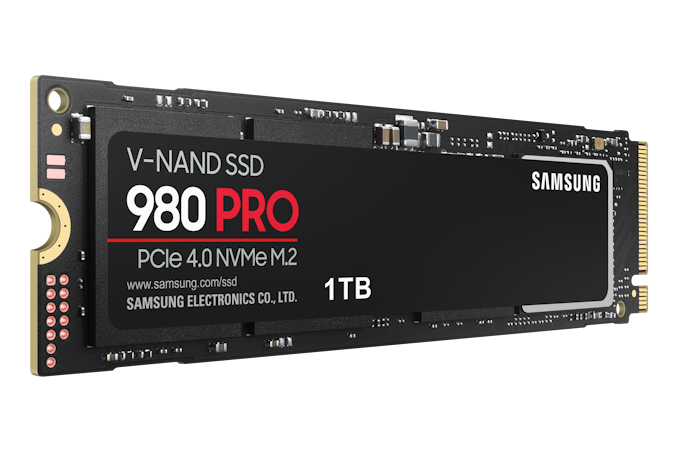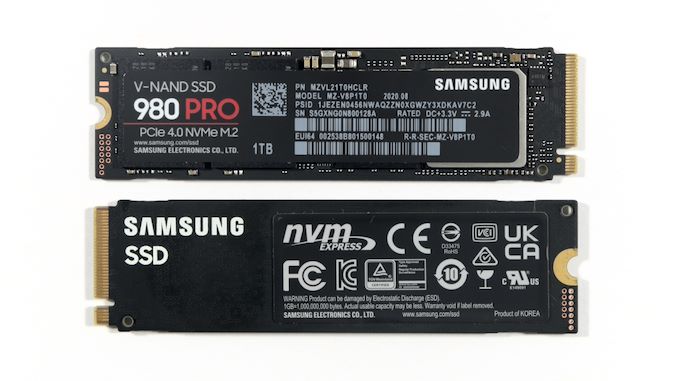The Samsung 980 PRO PCIe 4.0 SSD Review: A Spirit of Hope
by Billy Tallis on September 22, 2020 11:20 AM ESTSamsung 980 Pro: Top Shelf, No Drama
With the release this month of the Samsung 980 PRO, a new round of competition in the high-end SSD market is beginning. The 980 PRO boasts higher performance than any other consumer SSD currently available, including sequential reads at 7GB/s and random reads at up to a million IOs per second. Samsung is continuing their habit of retaking the SSD performance crown, and almost making it look easy. At the same time, the 980 PRO will be priced a bit more reasonably than previous Samsung PRO models thanks to the switch to more affordable TLC NAND. But focusing only on the raw performance capabilities of the 980 PRO can distract from its true purpose, and the real impact of the 980 PRO won't be as dramatic as those top line performance numbers would suggest.
The fundamental problem facing the 980 PRO and other high-end NVMe drives is that the rest of the system can't keep up. Very few real-world consumer workloads can keep this SSD busy enough to make good use of its full performance potential. Hitting 5-7GB/s or 1M IOPS certainly sounds impressive, but that's only possible in fairly unrealistic conditions. The high sequential transfer speeds can be of some use when transferring data between the 980 PRO and RAM or an equally fast SSD, but the peak random IO performance of the drive simply does not matter to consumers today.
PCIe 4.0 Testing Wasn't Easy: Watch This Space
Our soon-to-be-retired synthetic benchmark suite is single-threaded, and the new Ryzen-based testbed highlights the places where the old Skylake CPU has been the bottleneck for random IO. I don't consider this to be a serious problem with the results we've been reporting, because real-world applications need a lot more CPU time for processing data than they do for managing IO transfers. Hype for the upcoming generation of game consoles has suggested that future video games may reach the point of needing the equivalent of an entire CPU core to manage IO, but that's only after using the equivalent of several more cores to decompress data and feed it to a powerful GPU running the kind of game engine that doesn't exist yet. Our new benchmark suite will be designed with such workloads in mind, but current consumer workloads aren't there yet and won't be for at least a few years.

This is our PCIe 3.0 Intel Testing System.
We're building something similar for AMD Ryzen PCIe 4.0
Setting aside the issue of what the 980 PRO can do in contrived circumstances, it still offers improvements over Samsung's earlier TLC SSDs, but these are incremental changes rather than revolutionary. The 980 PRO is still constrained by the latency of NAND flash memory, even though Samsung's 128L TLC is a bit faster than their 92L and 64L generations. The switch to offering much larger SLC cache sizes probably matters a lot more than the addition of PCIe Gen4 support, and the modest power efficiency improvements are overdue.
With Enough Performance, Efficiency Should Be A Target
Moving to the latest NAND and using an 8nm process for the controller helps with power efficiency, but has nowhere near the impact of SK hynix's decision to build a high-end PCIe Gen3 SSD with a four-channel controller. For most consumer workloads that SK hynix Gold P31 is just as fast as the 980 PRO with its eight channel controller and twice the PCIe bandwidth.
Samsung's decision to use TLC NAND in the 980 PRO instead of the traditional MLC NAND for their PRO SSDs has raised some eyebrows, to say the least. Their PRO product line has long stood as one of the most premium options in the SSD market, and this change raises the question of whether the 980 PRO actually deserves that "PRO" moniker. This drive could easily have been labeled the 980 EVO instead, and it would have been a great successor to that product line.
By most measures and for most use cases, the 980 PRO is actually superior to the MLC-based 970 PRO. The addition of PCIe 4 support helps the 980 PRO deliver higher speeds than its predecessors, even though that's more forward-looking than an immediate benefit. The shortcomings relative to a hypothetical MLC-based PCIe 4 drive are also mostly hypothetical; workloads that truly require more write endurance than the TLC-based 980 PRO can provide should probably be handled by an enterprise SSD rather than any consumer/prosumer product. Even with TLC NAND, the 980 PRO offers buyers the security of knowing that the drive is more than capable of handling whatever they will throw at it, and that's reason enough for it to deserve the PRO label.
Samsung's Dilemma: What Goes Into A Mainstream 980 Evo?
But that does leave a gaping hole in Samsung's lineup where a more mainstream 980 EVO might go. Samsung probably wouldn't release a QLC-based NVMe drive using the EVO suffix while they are still trying to establish their QVO branding in the SATA SSD market. But using QLC NAND isn't the only way to make a more affordable mainstream alternative to the overkill that is the 980 EVO.
My bet is that Samsung is considering releasing another PCIe Gen3 drive, or a PCIe Gen4 drive that is significantly slower, cheaper and more power efficient. They've produced low-end client NVMe SSDs for the OEM market before, but never made a retail product out of them. Now might be the time for a successor to the PM971 and PM991 to find its way to the retail SSD market. Watch this space.












137 Comments
View All Comments
msroadkill612 - Tuesday, October 13, 2020 - link
Yep. I find the raw sequential speeds exciting too - its not just about IOPS :)This processor load balancing coincides w/ some very handy advances in mainstream system memory - typically? 64GB (2x 32GB 3200 cl16 ~$220 atm) w/ speeds to ~45-50GB/s on AM4?,
a PCIE 4 GPU w/ a 32GB/s link vs the former 16GB/s. Its little mentioned, but seems an important plateau - ~64GB at 32GB/s seems a pretty usable supplemental tier of cache for the gpu?
quite possibly, nvme ports on the GPU's Infinity Fabric bus on ~BigNavi to bypass a potentially bottlenecked pcie bus - AMD did it before with a pro Vega card - an nvme raid array on the gpu.
individually they are increments in currently usable gaming memory & bandwidth (if not IOPS), but collectively they could be a force which affects gaming?
Games are what they are due to the restrictions of yore. Of course they are coded to isolate within gpu resources.. it was the only way to run fast enough. Reduce the restrictions tho, & add new usable resources, & games change to provide new & richer experiences.
MS FS is perhaps a forerunner of this new mindset - it likes massive memory, but is fun at 30FPS.
crabperson - Tuesday, September 22, 2020 - link
Thanks for the comparison to the PM1725a, I didn't realize how the lack of an SLC cache hurt it so much! I got a used 3.2 TB 'b version for a song, still holding out on Haswell here and probably won't upgrade until next year (Zen 3 may convince me otherwise).Looking forward to Phison's updated controllers and 2TB+ drives next year. Definitely don't need to waste money on the Pro line anymore.
Billy Tallis - Tuesday, September 22, 2020 - link
I was actually surprised how poorly the PM1725a fared on the consumer tests. I knew that the lack of SLC caching would hurt its writes, but it also appears to be heavily optimized for high queue depths at the expense of low queue depth performance.I'm planning to have some overlap between the enterprise and consumer synthetic benchmarks going forward, so there should be more opportunities to notice stuff like this.
ZeDestructor - Tuesday, September 22, 2020 - link
Any particular reson for not running the 3 desktop loads as well? I'm curious how the drives perform in more "real-world" desktop workloads tooBilly Tallis - Tuesday, September 22, 2020 - link
Time constraints, mostly. I grabbed the PM1725a because of its potential to show similar peak throughput, and it takes less than two hours to run the synthetic tests. A full set of ATSB results is a minimum of 12 hours plus however long it takes to fill the drive twice.ZeDestructor - Wednesday, September 23, 2020 - link
Couldn't you do it during downtime and then lump the results directly into bench? I'm not particularly fussed about having the results in this particular review, but they would be very nice to have around eventually™ for weirdos like me who buy used server drives for cheap and stick em into the desktop.PopinFRESH007 - Tuesday, September 22, 2020 - link
The Rocket 4 Plus was already announced and should be shipping this year with what looks to be better performance than this. Will be interesting to see what the price will be. The E18 also supports NVMe 1.4 rather than 1.3c on the 980 Pro.ToTTenTranz - Tuesday, September 22, 2020 - link
So.. is this a SSD that can go into the PS5 as expandable storage?Billy Tallis - Tuesday, September 22, 2020 - link
Probably. Sony hasn't put out their list of officially approved/tested SSDs yet, but this one should qualify and then some.UltraWide - Tuesday, September 22, 2020 - link
The RANDOM R/W scores are average. It looks like the SK Hynix is a better SSD for real world use.